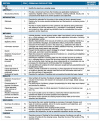Chordoma Genetic Aberrations and Targeted Therapies Panorama: A Systematic Literature Review
- PMID: 38731241
- PMCID: PMC11084907
- DOI: 10.3390/jcm13092711
Chordoma Genetic Aberrations and Targeted Therapies Panorama: A Systematic Literature Review
Abstract
Background: Chordomas pose a challenge in treatment due to their local invasiveness, high recurrence, and potential lethality. Despite being slow-growing and rarely metastasizing, these tumors often resist conventional chemotherapies (CTs) and radiotherapies (RTs), making surgical resection a crucial intervention. However, achieving radical resection for chordomas is seldom possible, presenting therapeutic challenges. The accurate diagnosis of these tumors is vital for their distinct prognoses, yet differentiation is hindered by overlapping radiological and histopathological features. Fortunately, recent molecular and genetic studies, including extracranial location analysis, offer valuable insights for precise diagnosis. This literature review delves into the genetic aberrations and molecular biology of chordomas, aiming to provide an overview of more successful therapeutic strategies. Methods: A systematic search was conducted across major medical databases (PubMed, Embase, and Cochrane Library) up to 28 January 2023. The search strategy utilized relevant Medical Subject Heading (MeSH) terms and keywords related to "chordomas", "molecular biology", "gene aberrations", and "target therapies". The studies included in this review consist of preclinical cell studies, case reports, case series, randomized controlled trials, non-randomized controlled trials, and cohort studies reporting on genetic and biological aberrations in chordomas. Results: Of the initial 297 articles identified, 40 articles were included in the article. Two tables highlighted clinical studies and ongoing clinical trials, encompassing 18 and 22 studies, respectively. The clinical studies involved 185 patients diagnosed with chordomas. The tumor sites were predominantly sacral (n = 8, 44.4%), followed by clivus (n = 7, 38.9%) and lumbar spine (n = 3, 16.7%). Primary treatments preceding targeted therapies included surgery (n = 10, 55.6%), RT (n = 9, 50.0%), and systemic treatments (n = 7, 38.9%). Various agents targeting specific molecular pathways were analyzed in the studies, such as imatinib (a tyrosine kinase inhibitor), erlotinib, and bevacizumab, which target EGFR/VEGFR. Common adverse events included fatigue (47.1%), skin reactions (32.4%), hypertension (23.5%), diarrhea (17.6%), and thyroid abnormalities (5.9%). Clinical outcomes were systematically assessed based on progression-free survival (PFS), overall survival (OS), and tumor response evaluated using RECIST or CHOI criteria. Notably, stable disease (SD) occurred in 58.1% of cases, and partial responses (PRs) were observed in 28.2% of patients, while 13.7% experienced disease progression (PD) despite targeted therapy. Among the 22 clinical trials included in the analysis, Phase II trials were the most prevalent (40.9%), followed by I-II trials (31.8%) and Phase I trials (27.3%). PD-1 inhibitors were the most frequently utilized, appearing in 50% of the trials, followed by PD-L1 inhibitors (36.4%), CTLA-4 inhibitors (22.7%), and mTOR inhibitors (13.6%). Conclusions: This systematic review provides an extensive overview of the state of targeted therapy for chordomas, highlighting their potential to stabilize the illness and enhance clinical outcomes.
Keywords: chordoma; genetic and molecular aberrations; systematic reviews; treatment implications.
Conflict of interest statement
The authors declare no conflicts of interest.
Figures



References
Publication types
LinkOut - more resources
Full Text Sources
Research Materials
Miscellaneous

